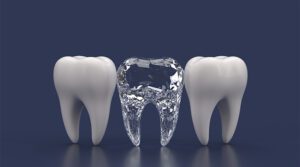Your medical adviser
Xavier Bourquin

Contact me on whatsapp directly
[ht-ctc-chat]
With a dental crown, we protect killed teeth, those with large fillings (fillings) and in case of loss of dental tissues over 50%

Unfortunately, over time, teeth begin to darken and lose their natural luster.
The good thing here is that advances in dentistry allow the restoration of teeth with different problems by different means.Crowning is the most commonly used method in dentistry to restore partially and severely damaged teeth.
With a dental crown we protect devitalized (killed) teeth, those with large fillings (fillings) and in case of loss of dental tissues over 50%. In addition to restoring the shape and protecting the tooth from breaking, through the crown we manage to restore normal function in the area. We improve the harmony of the dentition and achieve a high degree of aesthetics. We successfully close the interdental space, which leads to improved and comfortable nutrition, as well as better oral hygiene.
The metal ceramic crown is made of ceramic and metal, which is hypoallergenic and safe for health. This type of crowns are resistant for about 10-15 years. In addition to their resistance, they restore the functions of the teeth by repeating their shape exactly.
However, metal ceramic crowns also have their drawbacks. From an aesthetic point of view, their results are often unsatisfactory for patients, as the metal in them is dense and is a barrier to light.
A distinctive feature of porcelain structures is their strong strength. This type of crowns have a high aesthetic value, which makes them preferred among patients. This is because the shade chosen by the patient exactly repeats the color of the natural teeth and does not change over time.
It is virtually impossible to distinguish a fully Porcelain crown from a natural tooth.
One great advantage of Porcelain crowns over metal-ceramic ones is that when they are placed, the removal of the pulp is not necessary. The tooth under the crown remains alive, which protects it from premature destruction.
Zirconium is a rare natural material. In dental practice it is used for the production of zirconium crowns, and their advantages are many, which have proven their effectiveness in dental practice.
Their high natural aesthetics is one of the main ones. This is because zirconium crowns lack a metal skeleton that is transparent under the ceramic and gives the tooth a grayish appearance.
Zirconium is an extremely strong material with a resistance of 1000 to 1200 MPa.
In addition to strength, they have a very high abrasion resistance and can not be erased even under strong pressure or friction. At the same time they have a very light, gentle and fine structure. This makes them preferred by people suffering from bruxism.
But despite the pros, zirconium structures also have their drawbacks.
Natural teeth have a natural transparency, which is due to the transparency of the enamel. This problem can be easily solved with the use of special paints that mimic the transparency of the enamel.
These crowns lack allergic reactions and polymetallism. The body does not react to these bioinert materials. The high aesthetics of the material, as with porcelain crowns, makes them most suitable for restoration of front (front) teeth. These materials do not undergo color changes and retain their luster and freshness indefinitely.
There is one more thing – the constructions made of pressed ceramics and zirconium are produced with the help of digital technology. This minimizes errors so that the patient quickly gets used to the crowns and does not feel discomfort after placement.
Xavier Bourquin

Contact me on whatsapp directly